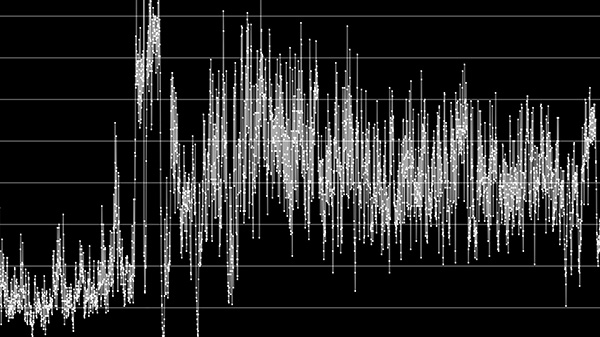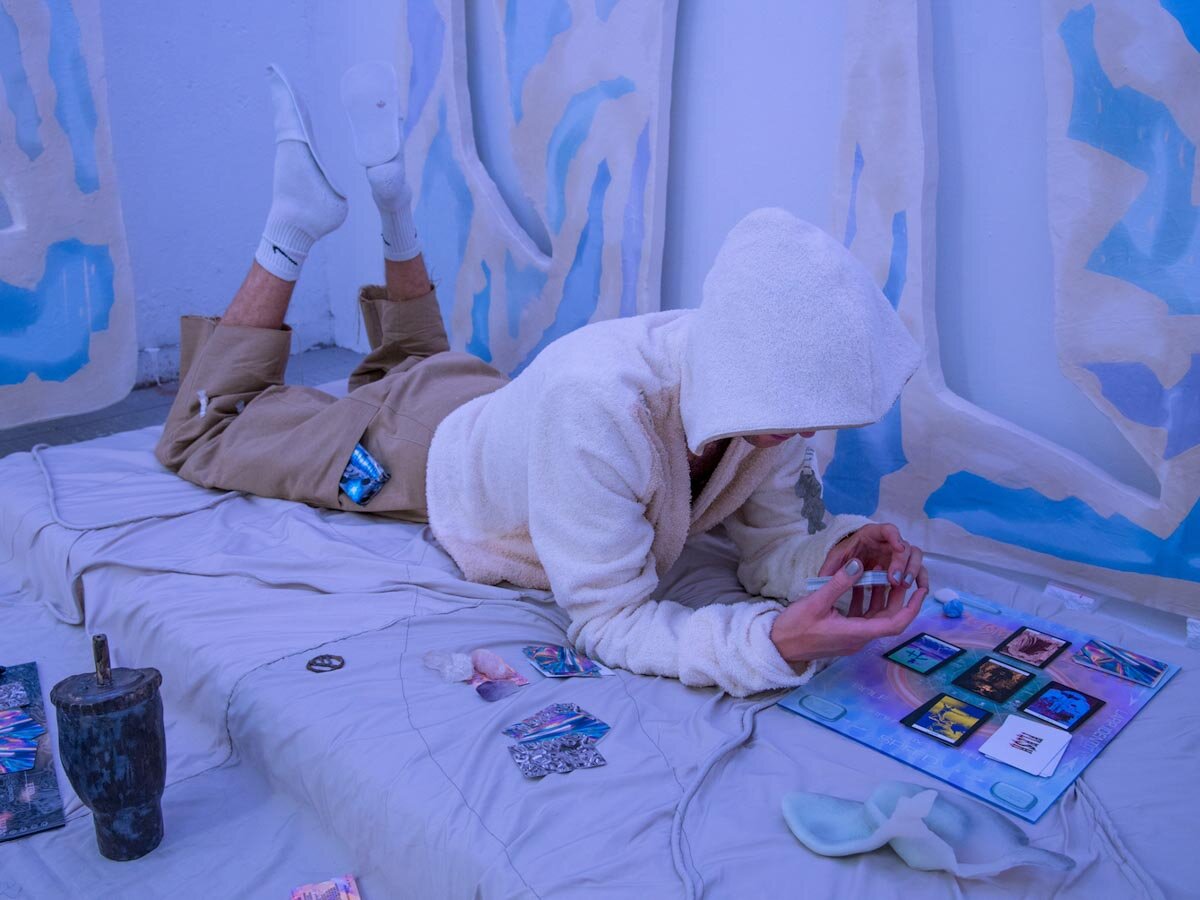“A deep, dark look into one’s self.”
Art is a system of control. Provocative, a half-truth for sure, this formulation nevertheless teases out something important. A domain without a clear purpose, art questions even the notion of purpose, and sometimes its anxieties presage a flood of control: making very refined objects; writing very deliberate and constrictive manifestos to decide what can and cannot be made and done - a pleasure taken in limitation, squeezing, prohibition, the forceful, ostensibly necessary stopping off of possibilities. In the middle of the 20th Century, art took on a billowing array of forms, and systems of yet more totalising control and assertive restrictions were imposed.
Deleuze’s famous 1990 five-page ‘Societies of Control’ argued that the coming (and now present) age would be characterised by the dissolution of I\[nstitutions: prisons, schools, factories, and so on, would instead spread more diffuse and modulatory control into the smaller-scale fabric of the world. The new technological realms mean new bodies, means new flesh for the managing through "pharmaceutical productions, molecular engineering, genetic manipulations,” a list to which we can add any number of other objects with the ring of the contemporary about them. Feelings and sociality are more and more systematised, disciplined, and controlled. Nature is less and less visible, even as 'nature’ starts to become increasingly the object of that control, and it slips from its plinth.
What does it mean for art to engage with this profusion of systems of control? I don’t exactly mean "how does it ‘resist’ them?", nor "how can we effectively ignore them?", and certainly I don’t mean "how can we reject them wholesale for a return to some fictional 'organic’ condition?" I mean how should art ‘push through them’, or ‘render them visible’, or even ‘embrace’ them? In the years since 9/11, artists have perhaps become more and more uncertain of attaining something like a good answer to this question. The fact of being a technically manipulated body, an ‘inforg’ to borrow terminology from the domain of digital ethics, a being saturated in informational flows, isn’t necessarily something to be bemoaned, or treated as horrifying development. There are, and maybe even it’s facile to say it, new pleasures to be made here.
Work that subjects the body to an exaggerated performance of control
Bring full-force to bear all the available technical resources onto the body; afford a new experience of the self-under-control. Marco Donnarumma’s installation-for-one Nigredo takes an audience member and straps them into a seat, wires them up to a sensor, partially strips them, and rocks them with powerful vibrations like an instrument. The limits of the self are broken, the self floods out as the other. Nigredo “unlocks the potential of the human body for different modes of operation […] It is an intimate and uncanny experience of one’s inner self.”
“In stark contrast with the long-established applications of sensory and perceptual deprivation for the development of torture and confinement techniques, perceptual deprivation is used in Nigredo as a means to unlock the potential of the human body for different modes of operation...In this state, the human body is not able to make a meaningful grouping of internal and external stimuli and thus the neurophysiological processes that drive the perception of both the environment and one’s own body are altered. The awareness distinction between what is part of one’s self and what is seemingly not is blurred. It is an intimate and uncanny experience of one’s inner self.”

Arthur Elsenaar / Perfect Paul
“us(ing) the muscles of the face as a composer in the twentieth century could use the newly liberated notes of the chromatic series”
Arthur Elsenaar’s work Perfect Paul applies small electrical pulses to the face, whose muscles twitch in response, a new facial choreography. The machine uses the muscles of the face as a composer in the twentieth century could use the newly liberated notes: in any order at all, in any combination at all, in any logically possible way. Elsenaar imprints logical categories into flesh. But he calls the work a ‘persona’. What does it mean to take the human face as a medium for art? Elsenaar’s face becomes doughy, malleable, but never quite generic. It is still, recognisably, the contorted face of a white middle-aged man, a demographic arguably required less frequently than others to do the work of affective labour, the work of assurance, the work of performing the emotions for the consumption of others that the face is often the site of. And yet the work can also be read as a fierce critique of the required manipulations of the face by services workers mandated to smile, to flirt, or to perform feeling anything at all.






























pplkpr's emotion classification algorithm was trained on open data published by academic researchers.
Heart rate variability is based on the balance between the sympathetic and parasympathetic nervous system, which operate at different frequencies.
Two pieces by Lauren McCarthy & Kyle McDonald, How we Act Together and pplkpr, stylise and exaggerate social affectivity as a product and symptom of control. In the former, an art website, you perform an affective gesture written on screen (nod, smile, etc.) whilst a video of the act recorded by other people plays through. If you can sustain the gesture for longer than anyone has previously, that is, if you outcompete your fellow audience members to be the most pleasing to the artwork, the video you are transmitting is appended to the video recorded on the site. When the next person comes along, they will also see you, and must outcompete you too.
pplkpr is an app. It integrates information from sensors on the body with calendar apps and photos to record your emotional responses to each of your friends. The app will note enjoyment that and schedule them back in. If you are not enjoying yourself, or are getting stressed out by someone, the app cancels your friendship. Here, the app asserts itself as the marker of truth: it knows you better than you, knows your self-deception, knows your flows of feeling inside and out.
“It gave me the excuse to cut toxic friends out of my life”
Omsk Social Club / LARPs
Work that renders visible mechanisms of control
Omsk Social Club make LARPs, Live Action Role Plays. Get together and engage with a fictional world, act out unscripted personae, submerge yourself momentarily into a different world, which always turns out to be made from the blocks of the old one. You must attempt to accomplish something in this game world. Strategies appear continuously as objects for your attention, overlapping and slipping over one another in their dash for supremacy like a cartoon pack of dogs in an endless GIF loop - now front, now back, now pulling into view, now biting at the necks of other strategies. In the act of attempting to live through these unfamiliar forms, you are continually pushing up against the exoskeleton of your accumulated habits, which push back at you, making them visible. But visibility does not make them controllable: they spill out beyond us, beyond anyone. What we learn from the visibilisation of the strategic is the endlessness of opacity.
Steve Mann / Eye Tap
EyeTap - a photographic engineer and inventor, Steve Mann was an early pioneer of wearable computing, whose inventions presaged the saturation of the contemporary visual and physical landscape by computation. The EyeTap gave him the ability to recall memories from his video capture technology, to call up information from the internet from what was right in front of him, and many more of the technical possibilities that have become second-nature to the experience of the contemporary world via our phones. Why it is that these technical possibilities, which seemed in some way to be revolutionising the world in the 1970s (by replacing the hardened and strictly interiorised subject with something like a more free-flowing exchange of information through the human/computer interface) have become since the prototypical markers of a governed subject?
Work that expands the range of the sensuous, and the range of the controllable
Another strategy in art has been the development of cyborg art, from Stelarc through Claudia Robles Angel. Cyborg art works towards the proliferation of new modes of the sensible, using technology to develop new senses, sometimes, such as in the case of Neil Harbisson, who was born colourblind, to replace experiences otherwise unavailable to the artist, but sometimes simply to deepen connection to the world. Moon Ribas has a sensor in her arm that vibrates when there is an earthquake, Joe Dekni has an echolocation sonar installed in his cheek, Manel Munoz has a permanently attached technology used to sense air pressure changes, https://www.cyborgnest.net/ offers NorthSense amongst other products, which allows you to continually keep track of north, situating yourself both in your current environment and in terms of a global orientation. What do all of these innovations mean? In part, they’re the development of the control of the sensible, but in their splitting off into different aesthetic registers for different people, feeling individually that which has never been felt before, they exemplify the process of atomisation, and the production of worlds beyond social connection.














